Meng Jiexiong
The 2024 version of the Implementation Rules of the Patent Law and the Guidelines for Patent Examination (hereinafter referred to as the Guidelines) was promulgated on December 21, 2023 and will enters into force on January 20, 2024. To adapt to the development of new fields and formats, and respond to the demands of innovative entities, the 2024 version of the Guidelines in Part II Chapter 9, within the framework of the latest Patent Law and its implementation rules, has adjusted the examination standards for invention patents involving computer programs.
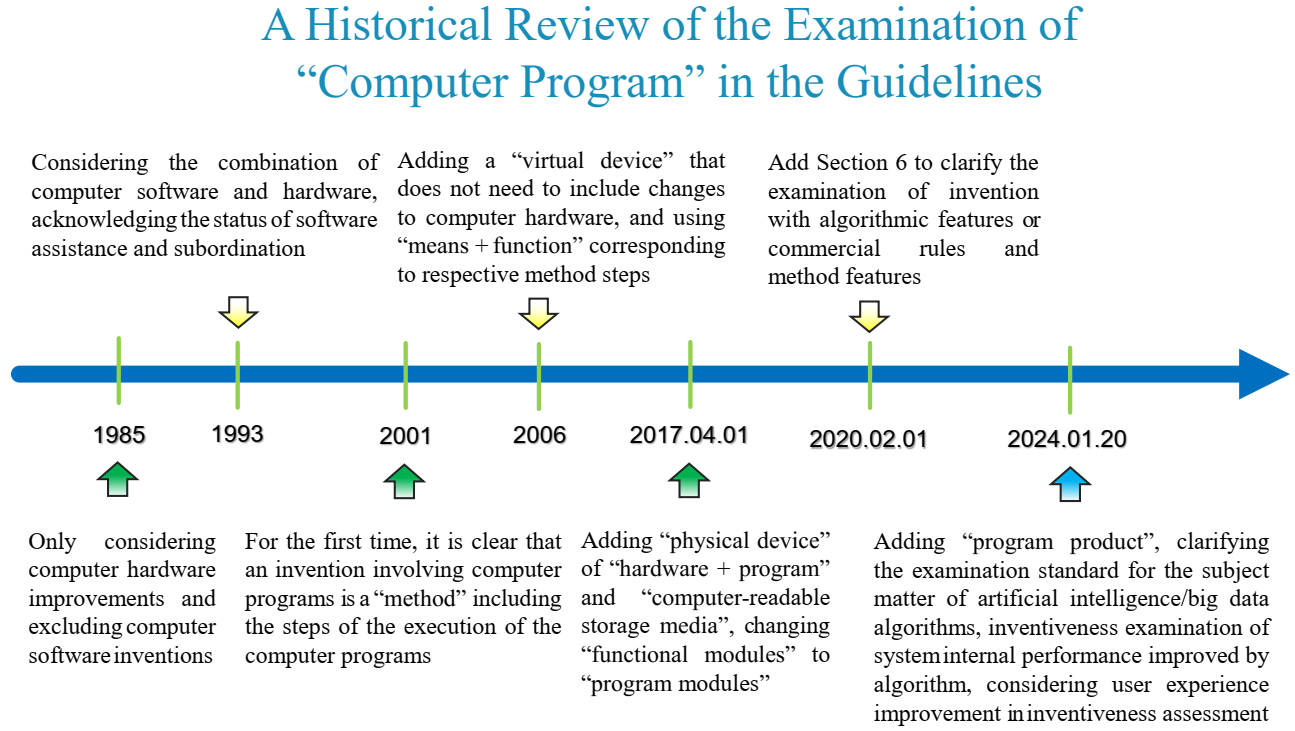
In fact, in response to the demand for further clarification of examination rules for patent applications related to new industries and fields such as artificial intelligence, the China National Intellectual Property Administration (CNIPA) announced on December 31, 2019 that new Section 6 is added to Chapter 9 of Part II in the Guidelines to specify the examination of invention involving artificial intelligence, “Internet +,” big data, and blockchain, etc., which was implemented on February 1, 2020.
Since, the CNIPA solicited opinions on the modification of Chapter 9 of Part II in the Guidelines twice, on November 10, 2020, and August 3, 2021, respectively.
Finally, to effectively strengthen the protection of invention patents in new formats and fields and provide guidance for the drafting and examination of application documents to enhance application quality, the 2024 version of the Guidelines, superseding the 2010 edition, made modifications in the following four aspects for Chapter 9 of Part II.
I. Addition of “Computer Program Product” as a Patentable Subject Matter
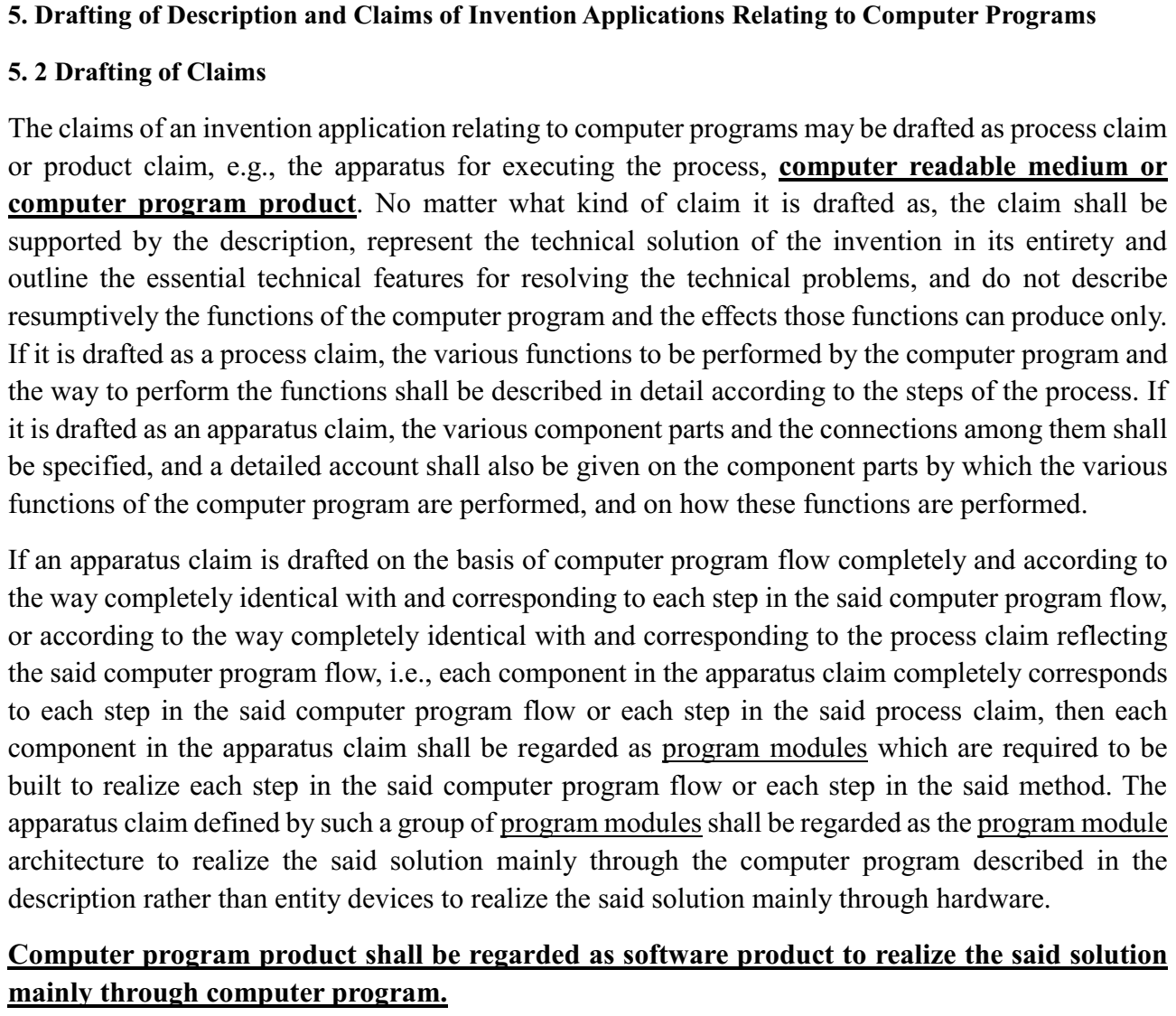
In 2017, the Decision of the CNIPA on Amending the Guidelines (Order No. 74 of the CNIPA) clarified the form of protection for computer-readable storage media storing computer programs. However, with the development of internet technology, more and more computer software is no longer dependent on traditional tangible storage media such as CD; instead, it can be transmitted, distributed, and downloaded through the internet from server(s) in the form of signals.
To strengthen software protection, the 2024 version of the Guidelines in Part II, Chapter 9, Section 5.2 has been revised to clarify “Writing of Claims” that claims related to invention patent applications involving computer programs can be written as computer program product or computer-readable storage medium (see Example 4). At the same time, the computer program product is defined as software product to realize the solution mainly through computer program.
In Section 5.2, examples of product claim such as apparatus including programs, computer program product and computer-readable storage medium are Example 4.
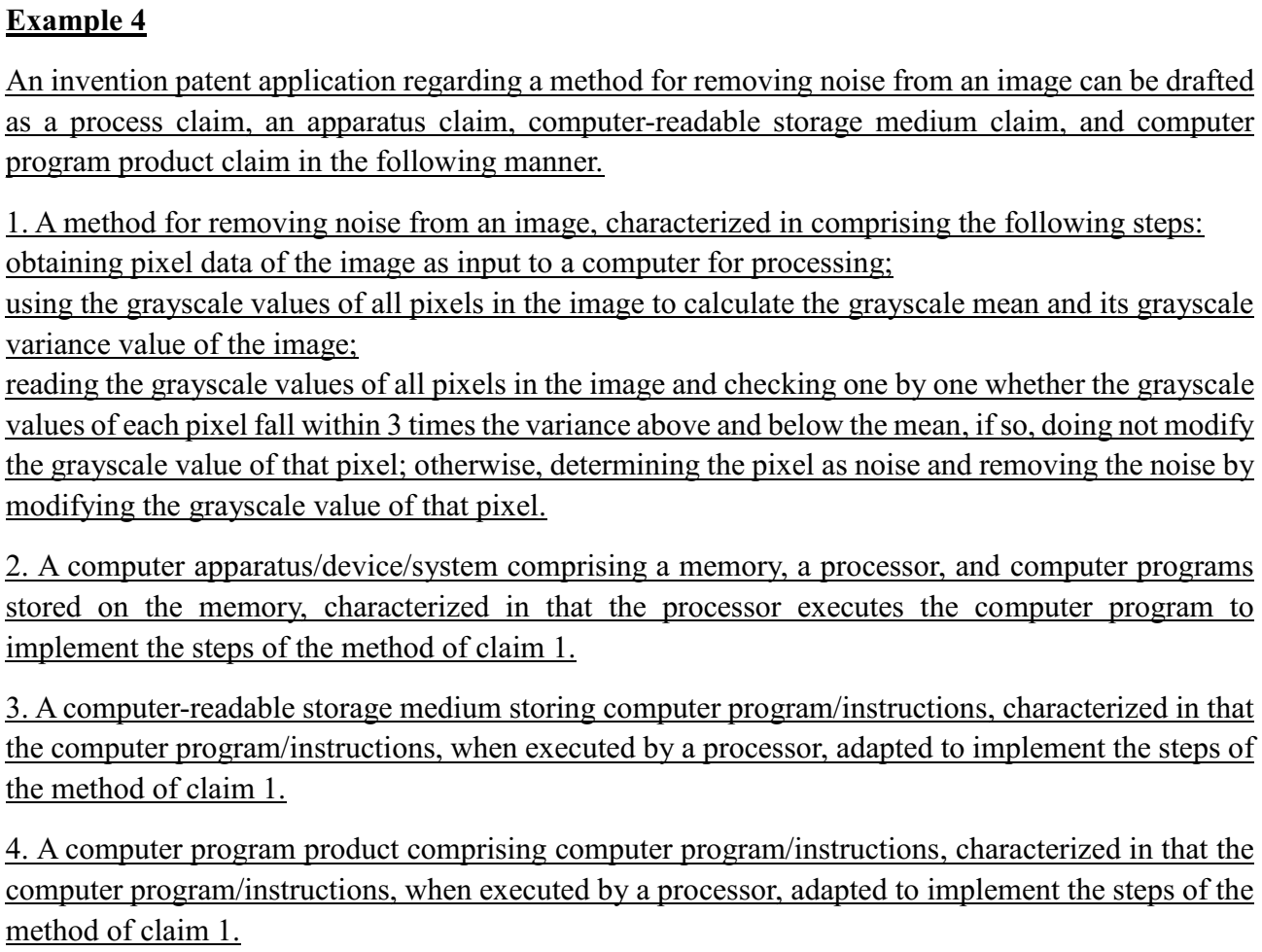
In fact, in addition to the four drafting ways mentioned in Example 4, the computer-implemented inventions (CII) can be drafted in the following fifth way which is a claim to an apparatus defined by a group of program modules:
5. An apparatus for removing noise from an image, characterized in comprising:
means for obtaining pixel data of the image as input to a computer for processing;
means for using the grayscale values of all pixels in the image to calculate the grayscale mean and its grayscale variance value of the image;
means for reading the grayscale values of all pixels in the image and checking one by one whether the grayscale values of each pixel fall within 3 times the variance above and below the mean, if so, doing not modify the grayscale value of that pixel; otherwise, determining the pixel as noise and removing the noise by modifying the grayscale value of that pixel.
Therefore, the computer-implemented inventions (CII) actually have five ways to draft claims, as shown in below, to obtain protection from different perspectives.
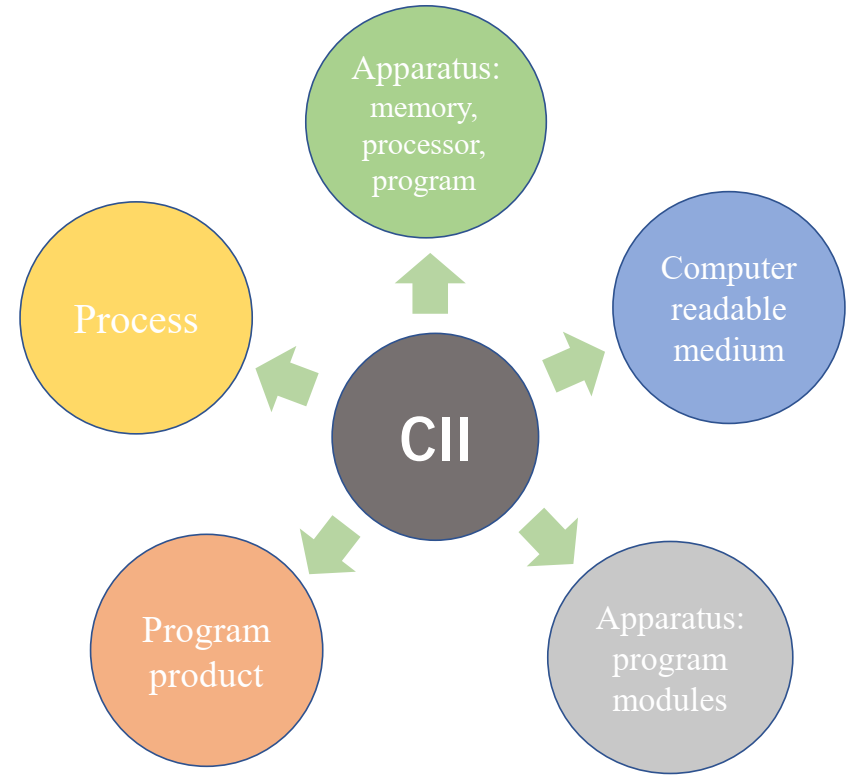
II. Refinement: Examination Criteria for Subject Matter in the Field of Artificial Intelligence and Big Data
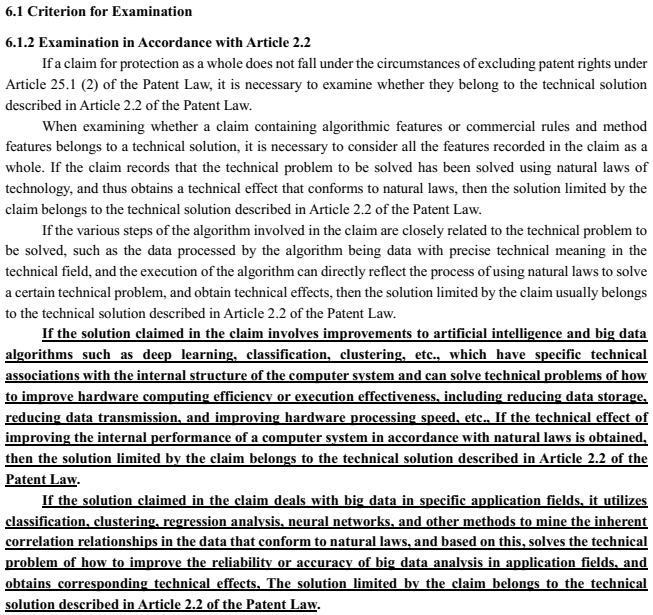
The 2010 edition of Guidelines in Part II, Chapter 9, Section 6.1.2, address the criteria for examination of Article 2.2 of the Patent Law:
l Overall consideration of all features (technical features + algorithm/business rules and method features), “Three-Element Judgment” (using technical means that conform to natural laws to solve technical problem and achieve technical effect that conforms to natural laws)
l Close relevance of algorithm steps to technical problem (e.g., data processed by the algorithm has precise technical meaning in the technical field), and the execution of the algorithm directly reflects the use of natural laws to solve technical problem (Example 2)
The 2010 edition of Guidelines adds the following examination criteria for Article 2.2:
l The algorithm in a claim must have a specific technical correlation with the internal structure of the computer system (in Example 5, the amount of training data is associated with the different processing efficiencies of single or multiple processors), achieving an improvement in the internal performance of the computer system, enhancing hardware computational efficiency and execution efficiency (including reducing data storage, decreasing data transfer, increasing hardware processing speed, etc.; Example 5 improves the execution effect of hardware during the training process)
l On the one hand, the big data processed by a claim should be applied to specific technical field (big data related to electronic coupons in Example 6; big data related to financial products in Example 10); on the other hand, inherent relationships that conform to natural laws should be extracted from the big data (Example 6 shows the inherent relationship between user behavior characteristics and the tendency to use electronic vouchers, Example 10 shows that there is no inherent relationship between historical price data and future price data of financial products).
III. Clarification: If the Algorithm Improves the Internal Performance of a Computer, the Contribution of the Algorithm Features to a Technical Solution should be Considered

The 2010 edition of the Guidelines in Part II, Chapter 9, Section 6.1.3, provides the examination criteria for novelty and inventiveness:
l Overall consideration of technical features as well as algorithm/business rules and method features that “support and interact with each other functionally”
l If the algorithm is applied to a specific technical field to solve specific technical problem, the algorithm and the technical features “support and interact with each other functionally”
l If the implementation of business rules and method features requires adjustments or improvements in technical means, they “support and interact with functionally” with the technical features
The 2024 edition of the Guidelines in Section 6.1.3 specifically states that
l if the algorithm has a specific technical correlation with the internal structure of the computer system, achieves an improvement in the internal performance of the computer system, and enhances hardware computational efficiency or execution effects, then the algorithm features “support and interact functionally” with the technical features. In determining the inventiveness, the contribution of the algorithm features to the technical solution should be considered.
The 2024 edition of Guidelines in Section 6.2 adds Example 15, “A method for adapting neural network parameters,” which clearly indicates that if the improvement of the algorithm itself enhances the computational efficiency of the hardware and achieves an improvement in the internal performance of the computer system, it demonstrates that the algorithm features “support and interact with functionally” with the technical features, and thus, the contribution of the algorithm features to the technical solution should be considered in determining the inventiveness.
IV. Further Clarification: Consideration of the Effectiveness of User Experience Enhancement Resulting from Technical Features in Inventiveness Assessment

The 2024 edition of the Guidelines in Section 6.1.3 for novelty and inventiveness examinations also specifies that the user experience effects brought about by technical features, or jointly brought about by technical features and algorithm/business rules and method features that support and interact with each other functionally should be considered in the inventiveness assessment.
Further, the 2024 edition of the Guidelines in Section 6.2 adjusts the original Example 9 to Example 13, and modifies the analysis and conclusion section to affirm the role of enhancing user experience effects resulting from technical features in the inventiveness assessment. That is to say, the improvement of user experience resulting from technical features is objective and not subject to individual preferences.
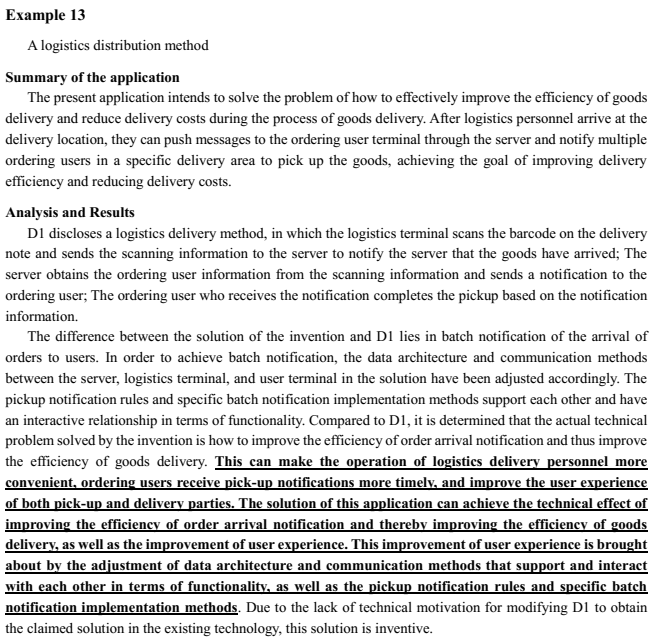
It is worth noting that if an invention objectively improves user experience, it is advisable to explain this in the specification. At the same time, it should be clarified how this improvement in user experience is brought about by the technical features and the algorithm/business rules and method features that support and interact with each other functionally.
In summary, the 2024 edition of the Guidelines provides detailed regulations for the examination rules of patent applications in the field of new formats and areas such as artificial intelligence, responding promptly to the needs of innovative entities and addressing issues in examination practices:
On one hand, it incorporates beneficial practices explored in examination practices into the Guidelines, unifying examination standards, clarifying that patent applications related to computer-implemented inventions can be written as a computer program product, and refining the examination standards for such applications.
On the other hand, while considering technical features as well as the rules and method features of intellectual activities such as algorithms or business rules and methods as a whole, it further clarifies that the effects of algorithm implementation on the internal performance of the computer should be considered during inventiveness examinations, as well as the user experience enhancement effects resulting from technical features.
Meng Jiexiong
Mr. MENG's practice focuses on patent drafting, filing and prosecution, patent invalidation and infringement litigation, patent assessment, and patent-related legal advice in the fields of medical device, image processing, electric engineering, computer science, mobile communication, etc. He has extensive experience in drafting patent applications, replying to office actions and appealing reexaminations. He has handled a great number of patent applications from famous medical companies in the world. He is good at technical understanding and analysis, and could always provide valuable suggestions for his clients. He is experienced in patent invalidation. The clients he served include Philips, ResMed, Panasonic, Qualcomm, Intel, etc.